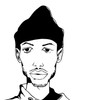'Conspicuous Fraud Series #1 (Eminence),' 2001. Oil on canvas, 791⁄2 x 791⁄2 x 31⁄2 in. (201.3 x 201.3 x 8.3 cm). The Studio Museum in Harlem; Museum purchase made possible by a gift from Anne Ehrenkranz. © Kehinde Wiley.
'Femme piquée par un serpent,' (2008). Oil on canvas, 102 x 300 in. (259.1 x 762 cm). © Kehinde Wiley.
Kehinde Wiley: Nothing has changed and everything has changed. I started off leaving Yale and coming to Harlem to witness the exchanges in the streets—looking around, trying to create portraiture that responded to this very vibrant, youthful energy of America. Later on, when the work became successful, I began traveling the world and recognized that the very same America, that urban sensibility, shows up all over the place. My work then began to respond to that story, and the story of that story. So really, it started with this concern around black American youth culture and that story led to Israel, Brazil, India, Sri Lanka, all within following the cultural temperature of something that is very American and very black.I know that in Kehinde Wiley: A New Republic, you are going to exhibit sculpture and stained glass works. How was working in those mediums different for you?
Those materials are radically different. Although I followed the same type of material trajectory, for me what I have always tried to do is look at the language of art history and think about staying present. The material reality is very different, but the human aspirations and the things that are being spoken about are quite similar. At the core they have to do with ego, valuation, and empire. So much of what I do is to look at the beautiful, terrible past and try to square that with a very nuanced reality that I know we all live in today.
'The Two Sisters,' (2012). Oil on linen, 96 x 72 in. (243.8 x 182.9 cm). Collection of Pamela K. and William A. Royall, Jr. © Kehinde Wiley. Photo by Jason Wyche.
In a sense, we are all victims of the misogyny and racism that exist in the world, no matter what our gender or race happens to be. I think that there are different strategies in depicting women in paintings than men. I think it was an exciting opportunity to build upon the vocabulary that I created with all the work coming out of America, coming out of black masculinity, and turning it all on its head. I was able to look at the notion of dominance—how someone fills up the four corners of the tableau. Domination of that space is a very revolutionary act. And to be able to hand those keys over to the depiction of black women is a really magical thing to do.Do you think your Two Sisters painting truly represents the lived experiences of the women depicted?
It's a tough question to answer because I'd go out to Brooklyn, Harlem, and the Bronx, where I'd run into women whose backstories are diverse as you can imagine. I don't necessarily know how to create something that is a catchall. I was much more concerned with power of the trappings that existed in older paintings.
'Two Heroic Sisters of the Grassland,' (2011). Oil on canvas, 96 x 84 in. (243.8 x 213.4 cm). Hort Family Collection. © Kehinde Wiley. Photo: by Max Yawney.
For years, I've been painting black men as a way to respond to the reality of the streets. I've asked black men to show up in my studio in the clothes that they want to be wearing. And often times those clothes would be the same trappings people would see on television and find menacing. And as a thinking, working artist you can't help but have your trajectory altered by the reality of the streets. For me, this is not a new story. I'm that kid who grew up in South Central Los Angeles in the 1980s in the specter of Latasha Harlins and LAPD police brutality. For me, all of that stuff is a very tried and true way black bodies are policed, controlled, and consumed. My work has always been a response to that.Going back to the beginning of your career, why was depicting black masculinity important to you?
Well, I happen to be a black man, and it was a self-reflective exercise on the ego and a way of reaching out and making sense of the world. At the core, every artist, no matter what his subject matter happens to be, has to be someone doing the looking. I began to really interrogate the act of looking. In doing so, you have to start with where you are. Then the next question became, "Do you have some kind of fidelity to the world that you were handed, or do you try and dream up an alternative vision?" And both of those options seem to be missing something and so where my work exists is at the crossroads of where those two, twin desires meet and can be re-imagined into a new republic.What does a Kehinde Wiley republic look like?
Well, it is a new possibility. A new republic is an ability to hold a mirror to what is and to be able to dream about what could be. And what you have in my work is one person's path as he travels through the world and there is no limitation of what is conceivable.
'Napoleon Leading the Army over the Alps,' 2005. Oil on canvas, 108 x 108 in. (274.3 x 274.3 cm). Collection of Suzi and Andrew B. Cohen. © Kehinde Wiley.
